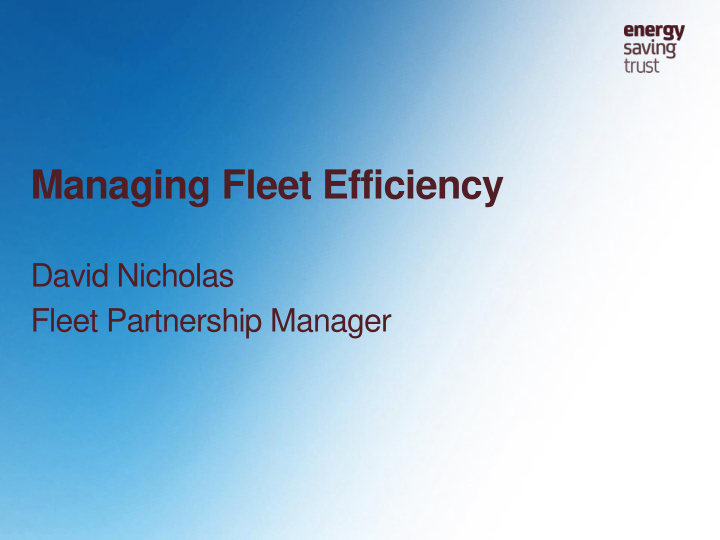



Managing Fleet Efficiency David Nicholas Fleet Partnership Manager
Agenda • Energy Saving Trust background/structure • Why bother? • Where to start? • Carbon footprints • Popular measures • Questions 2
EST Background • Formed in 1992 by government as an independent, impartial not-for-profit company • Social Enterprise with a Charitable Foundation (November’11) • Work with UK householders and organisations to help save energy, reduce carbon emissions and save money. • Delivering advice to organisations on sustainable transport since 2005. 3
EST Structure 4
Why bother? 5
Why Bother? • Cost – Fuel, taxation • Carbon – VED, BIK, Class 1A NIC, Capital Allowances all based on CO 2 • Care – Corporate Social Responsibility, Duty of Care 6
How much does a tonne of CO 2 cost? • Petrol • Diesel • 448.6 litres • 390.6 litres • Jan 02 = £318.39 • Jan 02 = £294.53 • Jan 04 = £344.84 • Jan 04 = £306.64 • Jan 06 = £400.90 • Jan 06 = £365.23 • Jan 08 = £467.71 • Jan 08 = £426.56 • Jan 10 = £501.35 • Jan 10 = £444.14 • Jan 12 = £596.41 • Jan 12 = £553.52 • Jan 13 = £592.83 • Jan 13 = £544.10 7
Where to Start? • Data gathering, analysis and management • Carbon footprint calculation • Implementation of reduction measures and policies • Review and revise 8
What Data? • Vehicle details – registration, make, model, fuel type etc • Annual fuel usage/annual business mileage per vehicle • Applies to ALL vehicles used on business 9
Carbon Footprints An accurate carbon footprint reflects: • The ability of an organisation to: – Report – Monitor – And manage core fleet costs • The approach taken to address Duty of Care issues – What are the employees driving (cash/grey)? – Does their business mileage place them at greater risk? 10
Carbon Footprints • Needs to include business travel in ALL vehicles • Calculation needs to be based on auditable metrics Method No Applied When Accuracy Litres of fuel used per vehicle over a given Most Accurate 1 time period is known CO 2 rating of the vehicle and annual mileage 2 are known Only the fuel type and engine size of the 3 vehicle are known plus the annual mileage. Only the vehicles fuel type and mileage are 4 known 5 Only vehicle mileage data is known Least Accurate 11
What Next? • Plug any gaps in data recording processes, for example – Fuel usage data – Business mileage data – Grey fleet data (vehicle, registration, mileage claimed) • Identify areas making the biggest contribution to carbon footprint • Examine areas and implement carbon (and cost) reduction measures 12
Example Measures • Vehicle procurement/choice – Whole life costs, downsizing, CO 2 limits • Fuel management – Purchasing policy, fuel economy benchmarks • Mileage reduction strategies – Where do staff go? reimbursement rates • Alternatives to private car use – Lease car, daily rental, pool car, car club • Use of technology – Speed limiters, telematics, stop/start, plug in vehicles • Driver training – Efficient driving techniques 13
Example Measures • Policies – Business travel, grey fleet, business mileage reimbursement 14
Review and Revise • Fast moving marketplace • What’s right now may not be right in 12 months time 15
Thank you 16
Recommend
More recommend